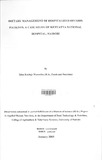| dc.description.abstract | A prospective study (qualitative in nature) was carried out on 56, purposively selected
my seropositive adult males and females hospitalized at the Kenyatta National Hospital,
situated in Nairobi. The objective of this study was to evaluate dietary management and
adequacy for hospitalized mY/AIDS patients.
Data collection was undertaken usrng a structured, pre-tested (and modified)
questionnaire for patients and relatives; key informant interviews; direct participant
observation; record of dietary intake of patients; patients anthropometry; weighing of
food; and case notes from patients files and records. Nutritional status was determined
using body mass index. Nutrient adequacy of hospital diets and home diets consumed by
study cases was computed using Food Composition Tables to calculate calories (energy),
proteins, carbohydrates and fat consumption. These variables were then compared to the
WHO recommendations for mY/AIDS - infected adults.
The study results show that the study cases (n=56) were relatively young adults with a
mean age of32 years (s.d 7.72). Two-thirds (62.5%) of the cases were married. Almost
all (94.6%) of the cases were literate and majority (50.0%) of them having attained
primary education, and 30.4% who had secondary education. A quarter (25.0%) of the
cases were unemployed and ill, hence with reduced productivity. About 23.3% were self
employed in small scale businesses and only 16.0% were in salaried employment.
Most (57.0%) of the cases had a diagnosis of pulmonary tuberculosis and were treated
using anti tuberculosis drugs mainly Ethambutol and Rifater. Among the 22 (39.3%)
malnourished cases, majority 14 (63.6%) had Pulmonary Tuberculosis (pTB).
Body mass index showed that majority (58.9%) of the cases were within normal limits,
hence had good nutritional status.
About 39.3% of the cases were malnourished using BMI (cut-off point <18.5) while
1.8% had BMI levels above normal limits (>25) hence obese. Among the malnourished
cases 40.0% were males and 38.7% were females.
The median BMI for both sexes were comparable, 18.8kg/m2 (13.4 - 24.4) for males and
18.8 kg/m' (11.6-29.2) for females, thus there was no significant difference in the BMI
levels between the sexes p<0.05 (p=0.82: Mann-Whitney test). BMI levels did not show
any significant association with appetite p<0.05 (p=0.38: Chi-square test). Majority
(65.0%, n=13) of the cases with poor appetites had normal BMI levels, while only
(35.0%, n=7) of the cases in the same category had BMI levels below the cut-off point
«18.5).
The hospital standard menu as a sole diet in the dietary management ofHIV/AIDS cases
shows that it was not adequate in energy and proteins as recommended by WHO. The
percent RDA contributed by the hospital diet was 69.7% for energy and 63.1% for
protein. However special diets significantly contributed to the energy p<0.05 (p=0.045:
Mann-Whitney test) and protein p<0.05 (p=0.013: Mann-Whitney test) intake of 30.0%
(n=17) of the patients being offered special diets by the nutritionist i.e. special milk,
special uji, fresubin, milk and eggs (high protein, high calorie diet) in addition to the
hospital diet. Also highly significant p<0.05 (p=<0.001: Chi-square test) was the fact that
out of the 33 (58.9%) of the cases who were not given dietary counseling services almost
all of them (n=31) were not offered special diets. Home diets complemented the hospital
diet by contributing 23.4% RDA for energy and 20.6% for proteins thus raising up
nutrient intake to 93.1% RDA for energy and 83.7% RDA for proteins. More (78.6%) of
the patients were able to consume >75% RDA as energy and protein (64.3%) when home
diets were considered. This study shows that home diet was statistically highly significant
p<0.05 (p=<0.001: Chi-square test) in complementing the nutrient adequacy of the
hospital diet. Appetite was found to be significant p<0.05 (p=O.004: Chi-square test) in
the increased intake of energy and protein when the hospital diet was complemented by
home diets. The opposite was also true. Inadequate energy and protein intake was highly
significant p<0.05 (p=<0.001: Chi-square test) among the cases who consumed below
75% of RDA for energy and protein after consuming both the hospital and home diets
combined. There was no significant difference between males and females in the intake
of energy p<0.05 (p=0.242: Mann-Whitney test) and protein p<0.05 (p=0.09: Mann-
Whitney test). Only about 41.0% of the patients received dietary counseling. Over threequarters
(80.0%) of the cases out of the 20 cases who reported to be having poor appetites
had not received dietary counseling. Poor appetite was highly associated p<0.05
(p=0.Ot7: Chi-square test) with inadequate dietary counseling.
This study established that hospital diets at Kenyatta National Hospital are not adequate
according to the WHO recommendations for mv/AIDS -infected adults and need to be
improved to fill in the nutrient gaps for energy and proteins contributed by the home
diets. This study recommends that hospital diets should meet at least 70% RDA for
energy and 77% RDA for protein so as to provide adequate energy and protein when
complemented by home diets. Adequate nutrition will enhance quick recovery, reduce
average length of hospital stay and therefore reduce hospital costs. Also more aggressive
dietary counseling should be undertaken for optimal nutritional care. | en |

